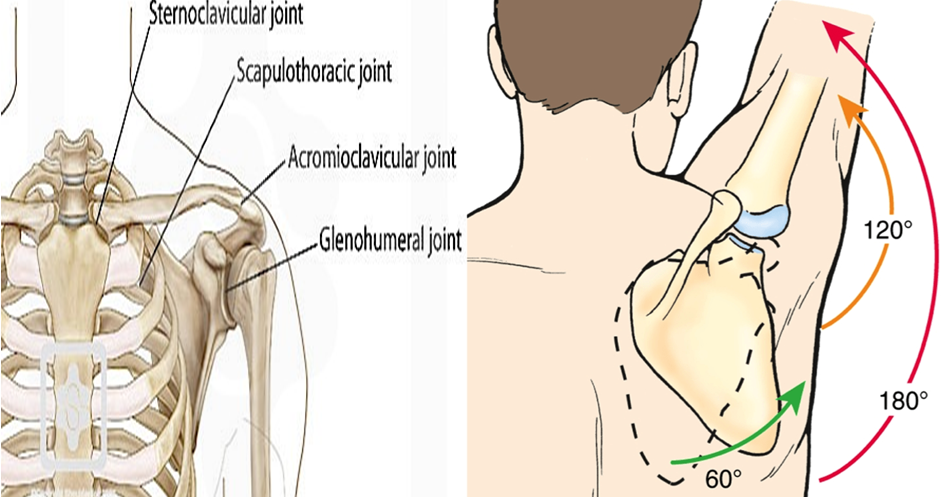Shoulder Impingement
What is shoulder impingement?
Shoulder impingement refers to a common condition where the structures in the shoulder become compressed or impinged, leading to inflammation, pain and limited range of motion. In shoulder impingement, the tendons and bursa of the shoulder joint can get irritated when the arm is lifted or moved. This can occur when there is inadequate space between the bones of the shoulder joint.

What are the main causes of shoulder impingement?
- Muscular imbalances - Weakness or tightness in the rotator cuff muscles as well as the serratus anterior and the lower trapzeius can affect shoulder stability and alignment, leading to impingement.
- Overuse or repetitive activities - Engaging in repetitive overhead activities such as throwing or swimming can lead to excessive stress, causing inflammation and irritation to the rotator cuff tendons.
- Poor posture - Rounded shoulders and forward head posture could alter the alignment of the shoulder joint, narrowing the space where the rotator cuff tendons pass through.
- Trauma - Traumatic injuries such as dislocations and fractures could alter the normal structures and mechanics of the shoulder joint.
- Degenerative changes - osteoarthritis could develop bone spurs, which can also narrow the joint space for the rotator cuff tendons.
What are the main symptoms of shoulder impingement?
- Shoulder pain: Pain is typically felt on the front or side of the shoulder and may radiate down the arm. The pain is often described as a dull ache or a sharp stabbing sensation.
- Pain aggravated with specific movements: Certain movements, such as reaching overhead, lifting weights or throwing, may exacerbate the pain and discomfort in your shoulder.
- Weakness or loss of strength - You may experience weakness in the affect shoulder, particularly when attempting to lift objects or perform overhead activities. This weakness can affect your ability to perform daily tasks or participate in sports or recreational activities.
- Limited range of motionL Shoulder impingement can lead to decreased flexibility rand range of motion in the affect shoulder. You may find it challenging to reach overhead, behind your back, or across your body.
- Night pain - Some individuals may experience increased pain and discomfort, particularly when lying on the affect shoulder while sleeping.
It is important to note that these symptoms can vary in intensity from person to person. If you’re experiencing any of these symptoms, it’s adbisable to consult with a healthcare professional such as a doctor or physical therapist for a proper diagnosis and treatment.

What are the main muscles involved?
The four main muscles involved are a group called the rotator cuff, which work in unison to provide stability to our shoulder joint. They are the supraspinatus, infraspinatus, teres minor and subcapularis.
The Suprasinatus runs along the upper part of the shoulder blade and is responsible for initiating shoulder abduction, where your arm is raised to the side. This muscle is also particularly susceptible to impingement, and can become compressed leading to inflammation.
The
infraspinatus and teres minor are located on the back of the shoulderblade.
They are responsible for shoulder external rotation, where your arm is rotated
outward. Weakness in these muscle can lead to poor movement quality.

How do we assess for shoulder impingement?
Detailed
history of the injury, strength and range of motion of the shoulder will be
assessed for signs of shoulder impingement.
Special tests can be used to confirm the presence of shoulder impingement. These include:
1. Neer’s test - The physiotherapist stabilizes the patient’s scpaula, and passively flexes until the end range, while it is internally rotated. Pain indicates a positive test.

2. Hawkins-Kennedy Test - The physiotherapist flexes the patient’s arm to 90 degrees, with 90 degrees of elbow flexion, afterwards internally rotating the arm. Pain indicates a positive test.

3. Empty can test - The physiotherapist flexes the arm to 90 degrees in the scapular plane, with a fully extended, internally rotated elbow and pronated forearm. Afterwards a downward resistance is applied. Pain or weakness against resistance indicates a positive test.

Are there any lifestyle changes that can help manage shoulder impingement?
- Improve posture - Practicing good posture throughout the day during sitting, standing or walking will help symptoms. Keep your shoulders back and down and avoiding a rounded shoulder and forward head posture. Doing so will help maintain proper alignment and reduce unnecessary strain on the shoulder joint.
- Ergonomic adjustments - Ensure that your workstation or any equipment you use regularly is ergonomically designed and properly set up. Adjust your desk, chair, and computer monitor height to promote good posture and reduce strain on the shoulders.
- Regular breaks and movement - Take frequent breaks if you engage in activities that require repetitive shoulder movements or prolonged sitting. Incorporate stretching exercises and shoulder mobility exercises into your routine to keep the shoulder joint flexible and reduce stiffness.
- Strength training - Engage in regular exercise and strength training, focusing on exercises that promote shoulder stability and mobility.
Are there any exercise or stretches that can help with shoulder impingement?
1. Shoulder Blade Squeezes: Stand or sit up straight with your arms by your sides. Squeeze your shoulder blades together and hold the position for 5-10 seconds. Release and repeat for 10-15 repetitions. This exercise helps improve posture and strengthen the muscles that support the shoulder blades.

2. External Rotation: Lay on your side. Hold a resistance band or a light dumbbell with your affected arm. Keep your elbow bent at a 90-degree angle. Slowly rotate your forearm outward, away from your body, while keeping your upper arm stable. Return to the starting position and repeat for 10-15 repetitions. This exercise targets the muscles of the rotator cuff, helping to improve shoulder stability.

3. Doorway Stretch: Stand in a doorway and place your hands on the door frame at shoulder height. Step forward with one foot, allowing your chest to stretch forward gently. You should feel a stretch in the front of your shoulder and chest. Hold the stretch for 20-30 seconds and repeat 2-3 times. This stretch helps improve flexibility in the front of the shoulder and chest muscles.

What physiotherapy treatment is available?
Physiotherapy
will aim to address muscular imbalances through strengthening and stretching
rehabilitation. Additionally, deep tissue massages, acupuncture and dry cupping
can help alleviate symptoms and improve recovery times.
How long does it take to recover from shoulder impingement?
In general, with proper treatment and adherence to a rehabilitation program, most individuals can expect to see improvement within a few weeks to a few months. However, it's important to note that complete recovery may take longer, ranging from several months to even a year in some cases.
How can we help at My Sports Injury?
Our
clinic offers comprehensive and specialised care. Our focuses are on improving
movement quality, re-establishing activities of daily living and maining
optimal quality of life. Our professional practitioners have a depth of
knowledge and experience in proving high quality standard of care for
conditions such as shoulder impingement.
Some
of the specialist treatment techniques that we carry out are acupuncture, deep
tissue massages, dry cupping and patient tailored exercise rehabilitation which
can all help in alleviating symptoms.

References:
Admin. “Deep Tissue Massage Therapy
for Rotator Cuff - June 2023 - Pro Motion Healthcare.” Pro Motion Healthcare, 5 Aug. 2020,
promotionhealthcare.com/deep-tissue-massage-therapy-rotator-cuff.
Bakhshi, E. Ali, et al. “Comparison
of Four Physical Therapy, Massage Therapy, Mechanotherapy and Compound Programs
on Rotator Cuff Muscles in Patients Suffered From Shoulder Impingement
Syndrome.” Journal of Military Medicine,
vol. 12, no. 2, July 2010, pp. 81–88. www.militarymedj.ir/article-1-678-fa.pdf.
Creech, Julie A. “Shoulder
Impingement Syndrome.” StatPearls - NCBI
Bookshelf, 17 Apr. 2023, www.ncbi.nlm.nih.gov/books/NBK554518.
Ellenbecker, Todd S., and Ann Cools. “Rehabilitation of Shoulder Impingement Syndrome and Rotator Cuff Injuries: An Evidence-based Review.” British Journal of Sports Medicine, vol. 44, no. 5, BMJ, Apr. 2010, pp. 319–27. https://doi.org/10.1136/bjsm.2009.058875.
Farotech. “Rotator Cuff Tears Anatomy
| Town Center Orthopaedics.” Town Center
Orthopaedics, 24 Apr. 2023, www.towncenterortho.com/blog/rotator-cuff-tears-anatomy-and-causes-video.
Hegedus, Eric J., et al. “Physical
Examination Tests of the Shoulder: A Systematic Review With Meta-analysis of
Individual Tests.” British Journal of
Sports Medicine, vol. 42, no. 2, BMJ, June 2007, pp. 80–92.
https://doi.org/10.1136/bjsm.2007.038406.
Koester, Michael C., et al. “Shoulder
Impingement Syndrome.” The American
Journal of Medicine, vol. 118, no. 5, Elsevier BV, May 2005, pp. 452–55.
https://doi.org/10.1016/j.amjmed.2005.01.040.
Physiotutors. “Hawkins-Kennedy Test |
Subacromial Pain Syndrome (SAPS).” YouTube,
2 Oct. 2019, www.youtube.com/watch?v=X9YiuvQJVJc.
Physiotutors. “Jobe / Empty Can Test
| Subacromial Pain Syndrome (SAPS).” YouTube,
4 Oct. 2019, www.youtube.com/watch?v=DeO50UTxwoo.
Physiotutors. “Neer Test |
Subacromial Pain Syndrome (SAPS).” YouTube,
30 Sept. 2019, www.youtube.com/watch?v=nNyax0iocZo.
Seoexecutive. “Shoulder Pain Relief:
Causes, Treatments, and Prevention.” Portable
Physiotherapy Machine & Equipment- UltraCare PRO, 7 Mar. 2023,
ultracarepro.in/blog/shoulder-pain-relief-causes-treatments-and-prevention.
Therapy, Experience Physical.
“Shoulder Impingement — Experience Physical Therapy - Buffalo Grove, IL.” Experience Physical Therapy, 5 Jan.
2021, www.experiencept.rehab/blog/impingement.





